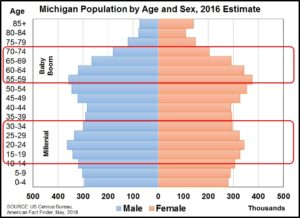The Fading Boom
Listening to an early summer storm the other evening, I heard one of the longest sustained rolls of distant thunder I have ever heard. I am sure it lasted at least 20 seconds, and I was struck by how long it took to completely fade out. But it did. And before too long, there was another roll. This reminded me of another fading boom and one not far behind. I’m talking about the fading Baby Boom and the Millennial Generation that is rapidly becoming more influential.
Big in Size and Influence Information about the preferences, perceptions, purchasing power, and politics of the Baby Boom generation, born between 1942 and 1960, has been a staple of research and news reporting for over four decades. This is understandable in some ways, given the sheer size of this generation and their share of the total population. But this was also a generation archetype (Idealists) in a repeating cycle of four that was fundamentally different from the previous generation in some important ways1. This, combined with their large numbers, resulted in a legacy of change as they moved through the decades of their lives.

Where are they now? One of the reasons you are starting to hear less about the Baby Boom Generation is that they are exiting the workforce. This started in the mid 2000’s when the oldest Baby Boomers were reaching their mid-60s. By 2020, when the youngest Baby Boomers, born in 1960, are 60 years old, most in that generation will have left the workplace, and those still working will represent a small minority of the workforce. One way to visualize this late stage of the Baby Boom generation “ripple” through the age brackets of the population is with a population pyramid of Michigan. The one at right shows the relative size of each 5 year increment age group in 2016. Baby Boomers are in the horizontal bars near the top (oldest age increments) of the pyramid.
Millennials: The New “Prime Time” Generation The second generation to follow the Baby Boom, the Millennials (born 1982-2004), is another large generation. And like the Baby Boom, their archetype (Civic) is one that has tended to usher in a lot of change, for different reasons and in different ways, but change none-the-less. This is part of the reason why there is an increasing amount of news about the preferences, perceptions, purchasing power, and politics of this generation, even as the news about the Baby Boomers fades away.
So What? Whether you are a business, a non-profit organization, or a government agency, the differences among the generations are driving, and will drive, changes in both your customer base and your employee and volunteer pools. Social scientists, businesses, marketers, and political parties are finding out, or already know, about the differences between Baby Boomers and Millennials, as well as The Silent Generation (born 1925-1942), Generation X (born 1961 – 1981), and Generation Z (born 2005-??). What do you know about these generations? More importantly, how has, or could, that knowledge influence your strategies and practices? What could it mean to your marketing (messages, channels), your portfolio of services and products (key quality characteristics, preferences), and HR strategy (recruitment & retention, rewards & recognition)?
Where to Start? I have a short “Primer” Presentation on Generations: Their Impact on The Market and The Workplace. I can also provide you with data on the generational composition of your market or service area and your employees and volunteers. More importantly, I can help you use this information to fine tune your strategies and policies. Contact me to set up a free initial consultation about how understanding Generations can help your organization.
Jeff
1 As described by authors William Strauss and Neil Howe in their books Generations (1991) and The Fourth Turning (1997), and in their consultancy.

Leave a Reply
Want to join the discussion?Feel free to contribute!